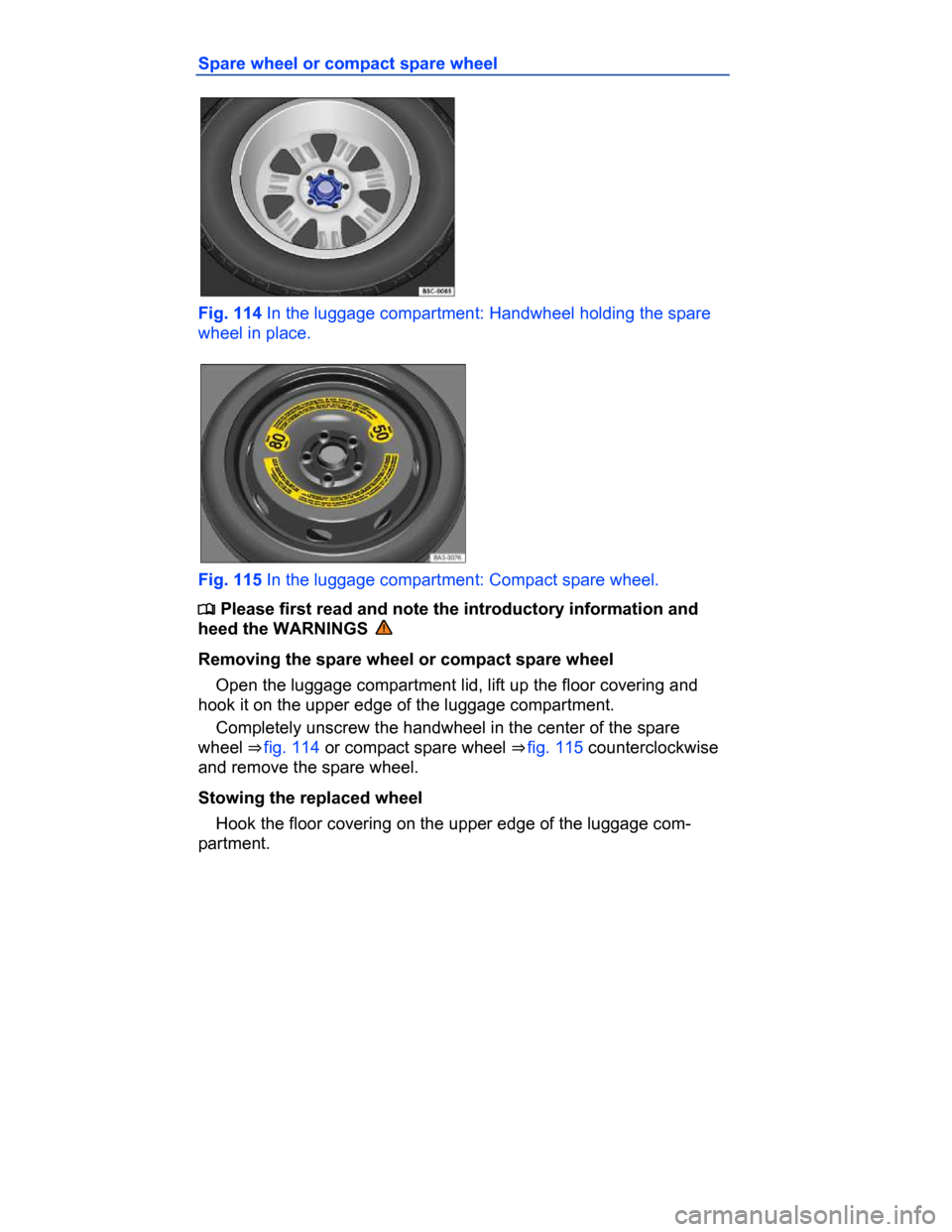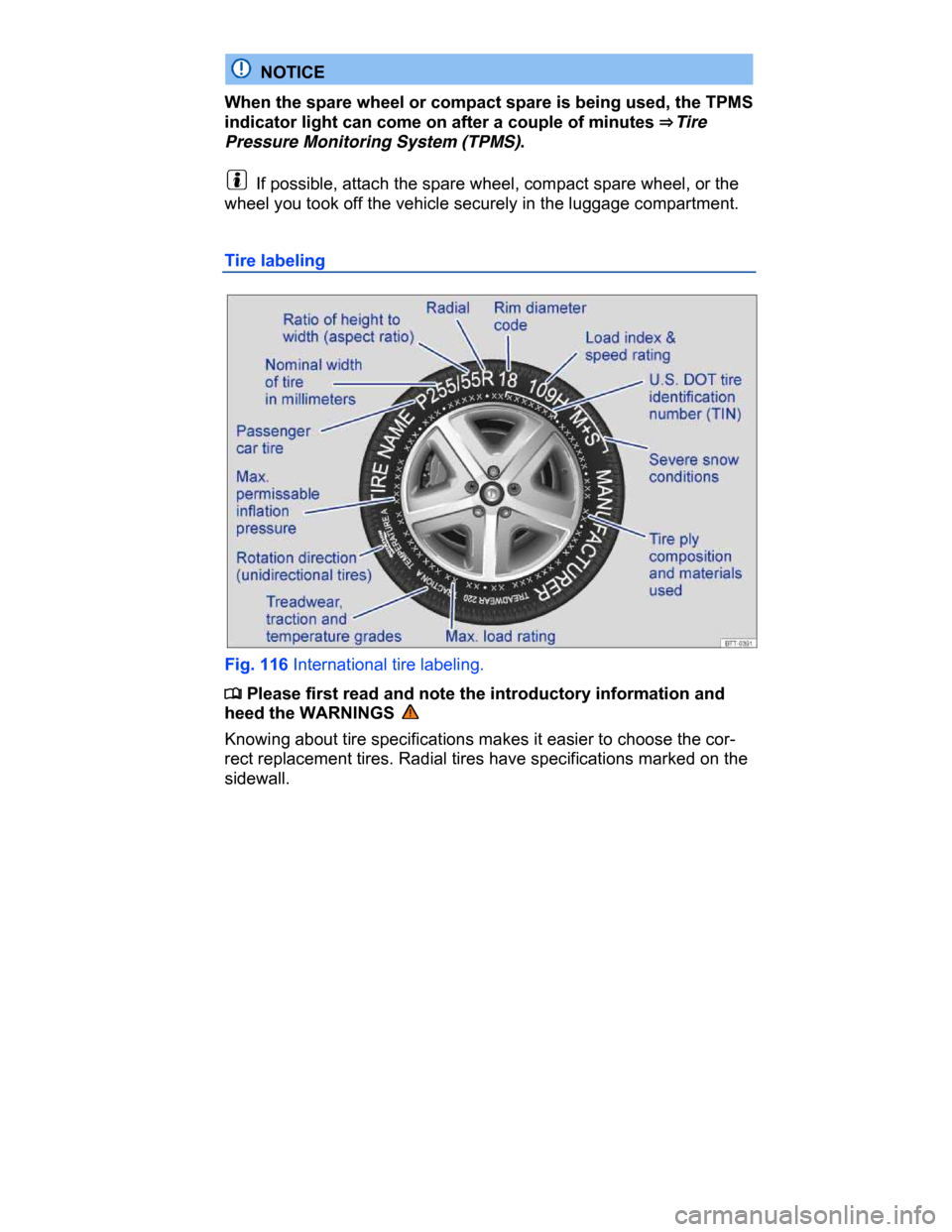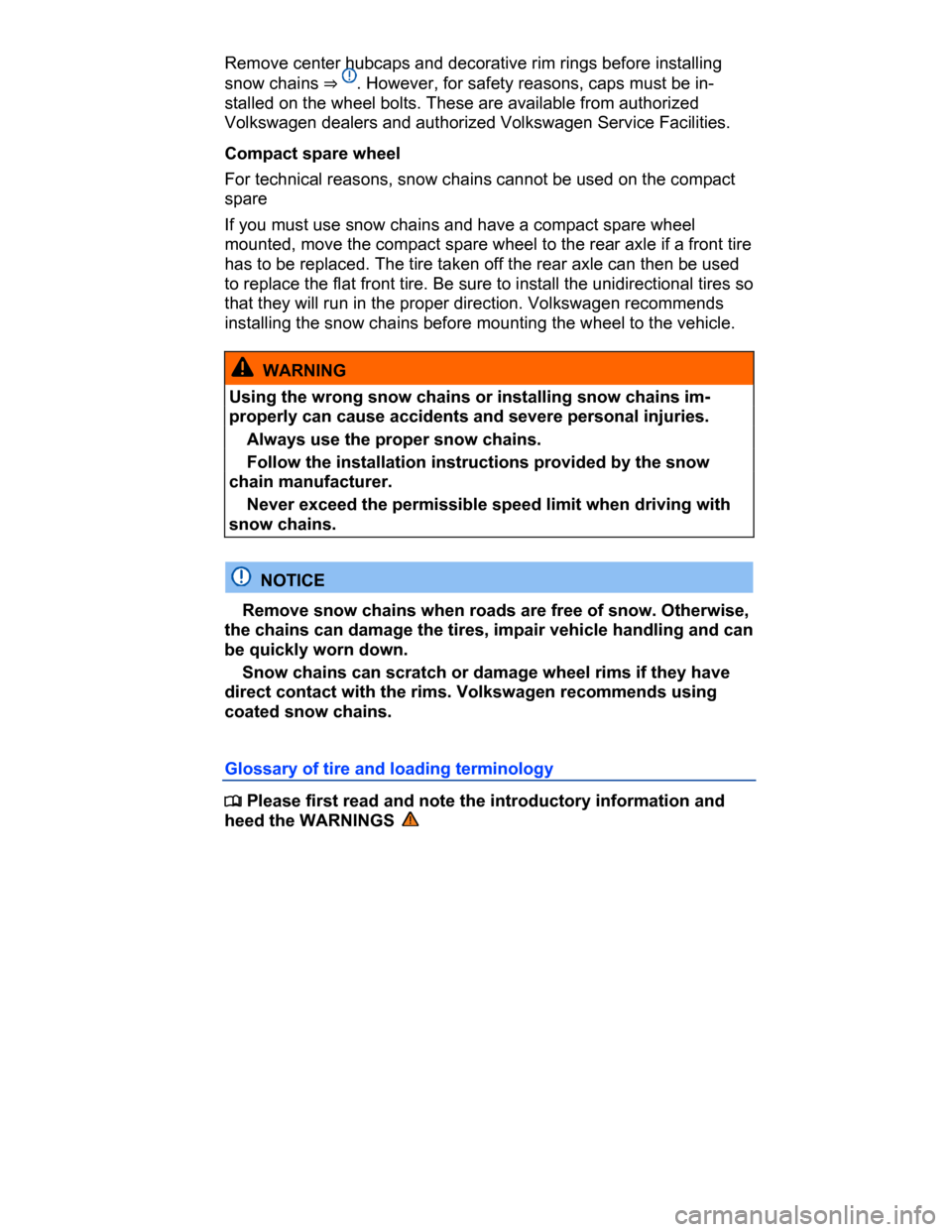spare wheel VOLKSWAGEN PASSAT CC 2015 1.G Owners Manual
[x] Cancel search | Manufacturer: VOLKSWAGEN, Model Year: 2015, Model line: PASSAT CC, Model: VOLKSWAGEN PASSAT CC 2015 1.GPages: 578, PDF Size: 8.42 MB
Page 230 of 578

The tires and wheels are essential parts of the vehicle's design. The
tires and wheels approved by Volkswagen are specially matched to
the characteristics of the vehicle for good road holding and safe han-
dling when in good condition and properly inflated.
Avoiding tire damage
� If you must drive over a curb or other obstacle, drive very slowly
and as much as possible at a right angle to the curb with the tire tread
of both front wheels contacting the curb at the same time.
� Regularly check tires for damage, such as punctures, cuts, tears
and blisters.
� Remove embedded material in the tread profile that has not yet
penetrated the inside of the tire ⇒ Tire wear and damage.
� Heed all warning messages from the Tire Pressure Monitoring Sys-
tem
� Replace worn or damaged tires immediately ⇒ Tire wear and
damage.
� Damage to tires and wheels is often not readily visible. If you notice
unusual vibration or the vehicle pulls to one side, this may indicate
that one of the tires is damaged. The tires must be checked immedi-
ately for hidden damage by an authorized Volkswagen dealer or an
authorized Volkswagen Service Facility. See also ⇒ Tire wear and
damage.
� Never exceed the load and permissible maximum speed rating of
the tires ⇒ Tire labeling.
� Always keep aggressive chemicals including grease, oil, gasoline
and brake fluid off the tires, including the spare wheel ⇒ .
� Replace missing valve caps immediately.
Unidirectional tires
Unidirectional tires are designed to rotate only in one direction. Unidi-
rectional tires have arrows on the sidewalls that show the direction of
rotation ⇒ Tire labeling. Unidirectional tires must always be mounted
according to the specified direction of rotation in order to deliver their
best grip, braking performance, low road noise, and good wear as
well as good hydroplaning resistance.
If you have to mount a tire opposite to its proper direction of rotation,
you must drive more carefully, since the tire is no longer being used
as designed. This is particularly important on wet roads. You must
Page 231 of 578

replace or remount the tire as soon as possible in order to restore the
correct direction of rotation.
Rotating tires
To help ensure even wear on all tires, regular tire rotation according
to the diagram ⇒ fig. 110 is recommended. In this way all tires can
have about the same service life.
Volkswagen recommends that you have your tires rotated by an au-
thorized Volkswagen dealer or authorized Volkswagen Service Facili-
ty.
Tires more than 6 years old
Tires age even if they are not being used. Physical and chemical pro-
cesses reduce tire strength and performance and cause them to
harden and become brittle. Old tires can fail suddenly and without
warning.
Volkswagen recommends replacing tires that are 6 years and older.
This also applies to tires that look new (an unused spare and the tire
on the compact spare wheel) or that seem to still be usable with tread
depth that has not yet reached the legal minimum depth ⇒ .
The age of each tire can be determined with the manufacturing date
that is part of the U.S. DOT tire identification number (�4�)�.) ⇒ Tire label-
ing.
Tire storage
Mark tires before removing them to help make sure that the previous
location (left, right, front, rear) and rolling direction can be maintained
when remounting them. Store tires in a cool, dry and preferably dark
place. Do not store tires mounted on wheels standing up.
Tires not mounted on wheels should be covered to help protect them
from dirt and stored vertically (sitting on the tread).
WARNING
Aggressive fluids and materials can cause visible and invisible
tire damage that can cause tire blowouts.
� Always keep chemicals, oils, grease, fuels, braking fluids and
other aggressive substances away from tires.
Page 236 of 578

� If a sensor for the Tire Pressure Monitoring System must be
replaced, the corresponding valve must be replaced at the same
time.
Always dispose of old tires in accordance with legal require-
ments.
TPMS wheel sensors are classified as Perchlorate Material –
special handling may apply. Obey all legal requirements regarding
handling and disposal of these components – see
http://www.dtsc.ca.gov/hazardouswaste/perchlorate. Obey all appli-
cable legal requirements regarding handling and disposal of the vehi-
cle or parts of its restraint system, including airbag modules and safe-
ty belts with pretensioners. Authorized Volkswagen dealers and au-
thorized Volkswagen Service Facilities are familiar with the require-
ments, and we recommend that you have them perform this service
for you.
If the replacement wheel is different from the tires that you have
mounted on your vehicle — for example, winter tires, wider, low-
profile tires or a compact spare — only use the replacement wheel for
a short time and drive cautiously.
� Replace it with a tire matching the others on your vehicle as soon
as possible.
Although tire size specifications can be the same, the actual di-
mensions may differ from those nominal values for different tire
makes, or the tire contours may be significantly different.
Page 238 of 578

� After adjusting the tire inflation pressures, make sure to screw the
valve caps back on; replace missing valve caps immediately. Please
read and heed the information on resetting the Tire Pressure Monitor-
ing System, if necessary ⇒ Tire Pressure Monitoring System (TPMS).
� Remember that the vehicle manufacturer, not the tire manufacturer,
determines the correct tire pressure for the tires on your vehicle.
Never exceed the maximum inflation pressure listed on the tire side-
wall for any reason.
Inflate a spare wheel to the pressure specified for the vehicle's road
wheels on the tire pressure label; inflate a compact spare wheel to
the pressure specified for the compact spare on the tire pressure la-
bel or on a separate label for the compact spare, if there is one.
WARNING
Incorrect tire pressure can cause a sudden tire failure or blow-
out, loss of control, collision, serious personal injury, and even
death.
� Always inflate tires to the recommended and correct cold tire
pressure before driving off.
� Low tire pressure can cause tires to get too hot, resulting in
tread separation, sudden loss of pressure, and blowouts. Tires
with excessively low pressure flex (bend) more, which can
cause the tire to overheat and fail suddenly without warning.
� Excessive speed and/or overloading can cause heat build-up,
sudden tire failure including a blowout and sudden deflation
and loss of control.
� If the tire pressure is too low or too high, the tires will wear
prematurely and the vehicle will not handle well.
� Regularly check tire inflation pressure, at least once a month,
and also especially before a long trip.
� Check the pressure in all 4 tires when the tires are still cold.
Never reduce air pressure in warm tires to match cold tire infla-
tion pressure.
NOTICE
� Make sure not to jam the tire pressure gauge into the valve
stem. Otherwise you can damage both the tire valves and the tire
Page 244 of 578

Spare wheel or compact spare wheel
Fig. 114 In the luggage compartment: Handwheel holding the spare
wheel in place.
Fig. 115 In the luggage compartment: Compact spare wheel.
�
Page 245 of 578

� Put the wheel you took off the vehicle into the spare wheel well so
that the center hole of the rim is aligned with the threaded pin.
� Turn the handwheel clockwise until the wheel is securely in place.
� If necessary, return the vehicle tool kit to its location in the luggage
compartment.
� Unhook the floor covering and fold it back down onto the floor of
the luggage compartment.
� Close the luggage compartment lid.
If the spare wheel is different from the road wheels
If the spare is different from the road wheels, a compact spare wheel,
for example, or if the road wheels are winter tires, the spare wheel
must be used only in the event of a flat tire, only for a brief time, and
only when driving with extra caution ⇒ .
Replace it with a tire matching the others on your vehicle as soon as
possible.
Please heed the following:
� Do not drive faster than 50 mph (80 km/h)!
� Avoid full-throttle acceleration, hard braking, and fast cornering!
� Do not use snow chains on the compact spare wheel ⇒Snow
chains.
� After installing the spare wheel or compact spare wheel, check the
tire pressure as soon as possible ⇒ Tire inflation pressure.
Check the tire inflation pressure of the spare or compact spare when-
ever you check the tire pressure of the road wheels, at least once a
month. Inflate a spare wheel to the cold tire pressure specified for
the vehicle's road wheels on the tire pressure label; inflate a compact
spare wheel to the cold tire pressure specified for the compact spare
on the tire pressure label or on a separate label for the compact
spare, if there is one.
Page 246 of 578

WARNING
Improper use of a spare wheel or a compact spare wheel can
cause loss of vehicle control, a crash or other accident, and se-
rious personal injury.
� Never use a spare wheel or compact spare wheel if it is dam-
aged or worn down to the wear indicators.
� In some vehicles, the spare wheel or compact spare wheel is
smaller than the original tire. A smaller compact spare wheel is
identified with a sticker and the words “50 mph” or “80 km/h”.
This is the maximum permissible speed when driving with this
tire.
� Never drive faster than 50 mph (80 km/h) with a compact
spare wheel. Avoid full-throttle acceleration, heavy braking, and
fast cornering!
� Never drive more than 125 miles (200 km) if a compact spare
wheel is installed on the front axle (drive axle).
� Replace the compact spare with a normal wheel and tire as
soon as possible. Compact spare tires are designed for brief
use only.
� Regularly check the U.S. DOT Tire Identification Number (TIN)
to determine the age of the compact spare wheel ⇒ Tire label-
ing. Tires age even if they are not being used and can fail sud-
denly, especially at higher speeds.
� Tires that are more than 6 years old can only be used in an
emergency and then with special care and at lower speeds.
� The compact spare wheel must always be secured with the
wheel bolts provided by the factory.
� Never drive using more than one compact spare wheel.
� After installing the compact spare wheel, the tire pressure
must be checked as soon as possible ⇒ Tire inflation pressure.
� Snow chains cannot be used on the compact spare wheel. If
you must use snow chains and have a compact spare wheel
mounted, move the compact spare wheel to the rear axle if a
front tire has to be replaced. The tire taken off the rear axle can
then be used to replace the flat front tire. Be sure you do not
change the tire's direction of rotation. Install the snow chains
on the full-sized road tire.
Page 247 of 578

NOTICE
When the spare wheel or compact spare is being used, the TPMS
indicator light can come on after a couple of minutes ⇒ Tire
Pressure Monitoring System (TPMS).
If possible, attach the spare wheel, compact spare wheel, or the
wheel you took off the vehicle securely in the luggage compartment.
Tire labeling
Fig. 116 International tire labeling.
�
Page 255 of 578

Remove center hubcaps and decorative rim rings before installing
snow chains ⇒ . However, for safety reasons, caps must be in-
stalled on the wheel bolts. These are available from authorized
Volkswagen dealers and authorized Volkswagen Service Facilities.
Compact spare wheel
For technical reasons, snow chains cannot be used on the compact
spare
If you must use snow chains and have a compact spare wheel
mounted, move the compact spare wheel to the rear axle if a front tire
has to be replaced. The tire taken off the rear axle can then be used
to replace the flat front tire. Be sure to install the unidirectional tires so
that they will run in the proper direction. Volkswagen recommends
installing the snow chains before mounting the wheel to the vehicle.
WARNING
Using the wrong snow chains or installing snow chains im-
properly can cause accidents and severe personal injuries.
� Always use the proper snow chains.
� Follow the installation instructions provided by the snow
chain manufacturer.
� Never exceed the permissible speed limit when driving with
snow chains.
NOTICE
� Remove snow chains when roads are free of snow. Otherwise,
the chains can damage the tires, impair vehicle handling and can
be quickly worn down.
� Snow chains can scratch or damage wheel rims if they have
direct contact with the rims. Volkswagen recommends using
coated snow chains.
Glossary of tire and loading terminology
�
Page 277 of 578

If the tire pressure is too low, the relevant tires and the respective
readings are highlighted in yellow.
Each tire, including the spare (if provided), should be checked month-
ly when cold and inflated to the inflation pressure recommended by
the vehicle manufacturer on the vehicle placard or tire inflation pres-
sure label. (If your vehicle has tires of a different size than the size
indicated on the vehicle placard or tire inflation pressure label, you
should determine the proper tire inflation pressure for those tires.)
As an added safety feature, your vehicle has been equipped with a
Tire Pressure Monitoring System (TPMS) that illuminates a low tire
pressure telltale when one or more of your tires is significantly under-
inflated. Accordingly, when the low tire pressure telltale illuminates,
you should stop and check your tires as soon as possible, and inflate
them to the proper pressure. Driving on a significantly underinflated
tire causes the tire to overheat and can lead to tire failure. Under-
inflation also reduces fuel efficiency and tire tread life, and may affect
the vehicle's handling and stopping ability.
Please note that the TPMS is not a substitute for proper tire mainte-
nance, and it is the driver's responsibility to maintain correct tire pres-
sure, even if under-inflation has not reached the level to trigger illumi-
nation of the TPMS low tire pressure telltale.
Your vehicle has also been equipped with a TPMS malfunction indi-
cator to indicate when the system is not operating properly. The
TPMS malfunction indicator is combined with the low tire pressure
telltale. When the system detects a malfunction, the telltale will flash
for approximately one minute and then remain continuously illuminat-
ed. This sequence will continue upon subsequent vehicle start-ups as
long as the malfunction exists.
When the malfunction indicator is illuminated, the system may not be
able to detect or signal low tire pressure as intended. TPMS malfunc-
tions may occur for a variety of reasons, including the installation of
replacement or alternate tires or wheels on the vehicle that prevent
the TPMS from functioning properly. Always check the TPMS mal-
function telltale after replacing one or more tires or wheels on your
vehicle to ensure that the replacement or alternate tires and wheels
allow the TPMS to continue to function properly.